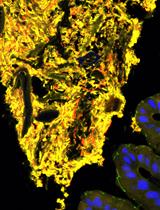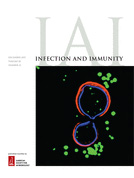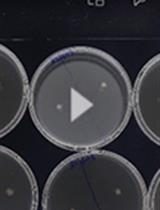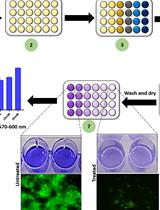- EN - English
- CN - 中文
Structural Analysis of Bordetella pertussis Biofilms by Confocal Laser Scanning Microscopy
利用激光扫描共聚焦显微镜研究百日咳杆菌生物膜的结构
发布: 2018年08月05日第8卷第15期 DOI: 10.21769/BioProtoc.2953 浏览次数: 6714
评审: Emily CopeJuan Facundo Rodriguez AyalaSofiane El-Kirat-Chatel

相关实验方案

从沙门氏菌鼠伤寒血清中纯化细菌淀粉样蛋白“Curli”并检测受感染宿主组织中的 Curli
Murugesan Sivaranjani [...] Aaron P. White
2022年05月20日 3014 阅读
Abstract
Biofilms are sessile communities of microbial cells embedded in a self-produced or host-derived exopolymeric matrix. Biofilms can both be beneficial or detrimental depending on the surface. Compared to their planktonic counterparts, biofilm cells display enhanced resistance to killing by environmental threats, chemicals, antimicrobials and host immune defenses. When in biofilms, the microbial cells interact with each other and with the surface to develop architecturally complex multi-dimensional structures. Numerous imaging techniques and tools are currently available for architectural analyses of biofilm communities. This allows examination of biofilm development through acquisition of three-dimensional images that can render structural features of the sessile community. A frequently utilized tool is Confocal Laser Scanning Microscopy. We present a detailed protocol to grow, observe and analyze biofilms of the respiratory human pathogen, Bordetella pertussis in space and time.
Keywords: Biofilm (生物膜)Background
Bordetella pertussis is an obligate human pathogen of the upper respiratory tract that causes whooping cough or pertussis (Mooi, 2010; Dorji et al., 2018). Biofilms of B. pertussis form on a variety of artificial surfaces and under static, shaking, and fluid flow conditions (Mishra et al., 2005; Sloan et al., 2007; Serra et al., 2011). Microscopic evaluation of these biofilms shows that this bacterium produces irregularly shaped microcolonies separated by fluid channels, embedded in an exopolymeric matrix composed by extracellular DNA (eDNA), proteins and polysaccharides (Parise et al., 2007; Sloan et al., 2007; Serra et al., 2008; Conover et al., 2011; Nicholson et al., 2012; Ganguly et al., 2014; Cattelan et al., 2017). In addition to forming biofilms in the laboratory setting, B. pertussis forms multi-dimensional organ-adherent biofilms on the nose and trachea during experimental infections of mice. Development of these mammalian biofilms is characterized by an extracellular polymeric matrix composed of eDNA, the Filamentous hemagglutinin protein and the Bps polysaccharide (Conover et al., 2010 and 2011; Serra et al., 2011; Dorji et al., 2018). Based on these results, biofilm formation has been proposed by us and others as a possible strategy adopted by B. pertussis to infect, persist and continually circulate in the community (Cattelan et al., 2016). Consistent with this hypothesis, we found that currently circulating strains from Argentina and USA produce significantly higher levels of biofilms when compared to a laboratory reference strain and colonize the mouse nose and trachea at higher numbers than the prototype laboratory strain (Cattelan et al., 2017). These results also provide evidence that hyperbiofilm growth is a strategy employed by circulating organisms to infect and survive inside their host.
In order to study the mechanisms involved in biofilm development, microscopic evaluation is a key technique that allows differentiation of the steps of the process, from adhesion to maturation and dispersion. In particular, confocal laser scanning microscopy (CLSM) is frequently used because it allows visualization of architectural complexities of intact and hydrated biofilms. In this protocol, we describe how to grow and process samples of B. pertussis biofilms, as demonstrated in our recent publication (Cattelan et al., 2017).
Materials and Reagents
- 0.2 μm filter
- Bacteriological Petri plates (Fisher Scientific, catalog number: FB0875712 )
- Sterile test tubes (17 x 100 mm, RPI, Research Products International, catalog number: 168599 )
- Serological pipettes:
5 ml pipette (SARSTEDT, catalog number: 86.1253.001 )
25 ml pipette (SARSTEDT, catalog number: 86.1685.001 ) - NalgeneTM 2 ml cryogenic tubes (Thermo Fisher Scientific, Thermo ScientificTM, catalog number 5000-0020 )
- Coverglasses, 22 x 22 mm (Fisher Scientific, FisherbrandTM, catalog number: 12-542B )
- NuncTM 6-wells plates (Thermo Fisher Scientific, Thermo ScientificTM, catalog number: 150239 )
- Aluminum foil
- Microscope slides (Fisher Scientific, FisherbrandTM, catalog number: 12-552-3 )
- Sterile disposable plastic material:
Posi-Click tubes (Denville Scientific, catalog number: C2170 )
P200 and P1000 tips (USA Scientific, catalog numbers: 1111-0706 and 1112-1720 ) - B. pertussis strain harboring a pGB5P1-GFP plasmid
- Defibrinated sheep’s blood (Hemostat Laboratories, catalog number: DSB100 )
- 50% glycerol solution (Fisher Scientific, catalog number: G33-1 )
- Kanamycin (Sigma-Aldrich, catalog number: K1377 )
- Neutralized buffered formalin (Fisher Scientific, catalog number: SF100-4 )
- Stainer-Scholte medium (Stainer et al., 1970; Nicholson et al., 2012)
- Sterile PBS (Thermo Fisher Scientific, GibcoTM, catalog number: 14190144 )
- ProLongTM Gold Antifade Mountant (Thermo Fisher Scientific, InvitrogenTM, catalog number: P36934 )
- DifcoTM Bordet-Gengou agar plates (BD, BD Biosciences, catalog number: 248200 )
- L-Proline (Sigma-Aldrich, catalog number: 131547 )
- KH2PO4 (Sigma-Aldrich, catalog number: V000225 )
- KCl (Sigma-Aldrich, catalog number: P3911 )
- MgCl2·6H2O (Sigma-Aldrich, catalog number: M2393 )
- CaCl2 (Sigma-Aldrich, catalog number: C1016 )
- Tris base (Sigma-Aldrich, catalog number: T1378 )
- NaCl (Sigma-Aldrich, catalog number: S7653 )
- FeSO4·7H2O (Sigma-Aldrich, catalog number: F8633 )
- L-cystine (Sigma-Aldrich, catalog number: C8755 )
- L-ascorbic acid (Sigma-Aldrich, catalog number: A5960 )
- Nicotinic acid (Sigma-Aldrich, catalog number: PHR1276 )
- Reduced L-glutathione (Sigma-Aldrich, catalog number: G4251 )
- SS medium (see Recipes)
- SS supplement (filter-sterilized) (see Recipes)
- Bordet-Gengou (BG) medium (see Recipes)
Equipment
- Kimax® Erlenmeyer flasks (125 ml) (DWK Life Sciences, KIMBLE®, catalog number: 26500 )
- Sterile forceps
- PIPETMAN® Classic (Gilson, models: P20, P200, P1000, catalog numbers: F123600 , F123601 , F123602 )
- Humid chamber (an appropriately sized Tupperware container with either a weigh boat containing water or paper towels soaked with water)
- Chemical fume hood (Hamilton Laboratory Solutions, model: PL-822 )
- Eclipse Ti-E inverted Confocal Microscope (Nikon, model: D-Eclipse C1si )
- Vortex (Fisher Scientific, catalog number: 02-215-365 )
- pH meter (Denver Instrument, model: UB-10 )
- Incubator (Thermo Fisher Scientific, Thermo ScientificTM, model: FormaTM Steri-CycleTM )
- Benchtop centrifuge (Eppendorf, model: 5418 )
- Refrigerator (4 °C) (Whirlpool, model: WRR56X18FW02 )
- -20 °C freezer (Kenmore, model: 253-26722103 )
- SPECTRONIC TM Spectrophotometer (Thermo Fisher Scientific, model: GENESYS 20 )
- Weigh Balance (Ohaus, model: Scout Pro SP202 and VWR, model: VWR-164AC )
- Roller Drum (Eppendorf, New BrunswickTM, model: TC-2 )
Software
- ImageJ (Schneider et al., 2012)
- COMSTAT2 plugin (Heydorn et al., 2000)
Procedure
文章信息
版权信息
© 2018 The Authors; exclusive licensee Bio-protocol LLC.
如何引用
Cattelan, N., Yantorno, O. M. and Deora, R. (2018). Structural Analysis of Bordetella pertussis Biofilms by Confocal Laser Scanning Microscopy. Bio-protocol 8(15): e2953. DOI: 10.21769/BioProtoc.2953.
分类
微生物学 > 微生物生物膜 > 生物膜培养
细胞生物学 > 细胞成像 > 共聚焦显微镜
您对这篇实验方法有问题吗?
在此处发布您的问题,我们将邀请本文作者来回答。同时,我们会将您的问题发布到Bio-protocol Exchange,以便寻求社区成员的帮助。
提问指南
+ 问题描述
写下详细的问题描述,包括所有有助于他人回答您问题的信息(例如实验过程、条件和相关图像等)。
Share
Bluesky
X
Copy link










